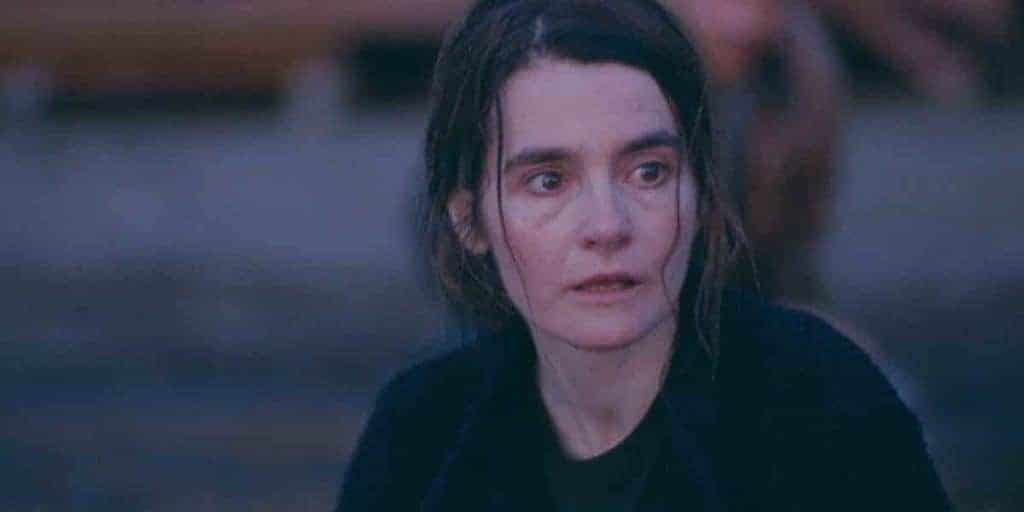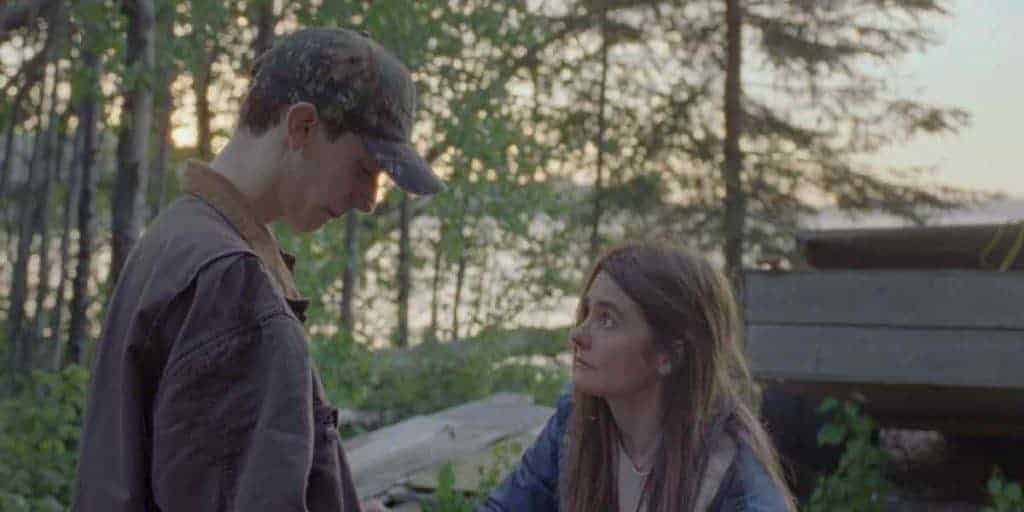Canadian Director Kathleen Hepburn discusses her feature debut,Never Steady, Never Still, which beautifully tackles Parkinson’s disease.

Kathleen Hepburn’s feature debut beautifully tackles the difficult and underrepresented subject of Parkinson’s disease. This degenerative disorder of the central nervous system affects mostly the motor system but can also lead to dementia in its more advanced stages. Never Steady, Never Still follows the parallel and interconnected stories of two characters at a crucial moment of their lives. Judy (Shirley Henderson), a middle-aged woman who has suffered from the disease for most of her married life, finds herself in a difficult situation when her husband, Eddie (Nicholas Campbell), suddenly dies. Rather than staying to take care of her, her son, Jamie (Théodore Pellerin), is forced to go work far away from home to make enough money to pay for her medication — all the while facing his own frustrations and nascent desires.
Shot against the gorgeous landscapes of British Columbia, and carried by a moving performance from Shirley Henderson, Never Steady, Never Still is a promising debut from Vancouver-born director Kathleen Hepburn. Back at TIFF17, The Seventh Row talked to her about the inspiration behind the film, working with people suffering from Parkinson’s disease, and the beauty of sad films.
Seventh Row (7R): You previously made a short film also named Never Steady, Never Still. How did the project of making a feature length version come along?
Kathleen Hepburn: I had the script of the feature ready before I started the short, so it was actually the opposite process: I was pulling scenes from the feature to do the short. But making the short film was a really valuable experience in that I got to try things out and learn what not to do. The feature is much closer to the way I had envisioned the project.
7R: Why the theme of Parkinson’s disease?
Kathleen Hepburn: I started writing about a family dealing with Parkinson’s because my mother has had Parkinson’s for 24 years now. I didn’t actually start up trying to write a script about Parkinson’s, but I wrote the character of the mother, and that’s the mother that I’ve known. It just happened. Then, Parkinson’s became much more central to the story.
7R: How did you make sure the representation of the disease would be realistic?
Kathleen Hepburn: The thing with Parkinson’s is that the symptoms are very varied. It can appear as so many different things. But one of the major things is the tremor. The way [lead actor Shirley Henderson] does it in the film is very realistic. The difficulties to speak, too. She also did a fantastic job, for example, in the scene where Judy is getting out of bed and has to use her whole body to get that momentum to get herself up.

7R: How did you work with Shirley Henderson on Never Steady, Never Still?
Kathleen Hepburn: She’s a really amazing actress and very easy to work with. She was in Scotland when we cast her, and I didn’t get to meet her until we got to the location of the shoot. So she did a lot of preparation alone. Because it’s a very physical disease, she had to practice for hours to learn how to get up, how to fall down, how to walk convincingly.
[clickToTweet tweet=”‘It’s a very physical disease. She had to practice for hours to learn how to get up, how to walk convincingly.'” quote=”‘It’s a very physical disease. She had to practice for hours to learn how to get up, how to walk convincingly.'”]
She said that she studied various people who had Parkinson’s and narrowed it down to a few very specific movements that she thought the character could embody. She practiced a lot until the movements became sort of second nature. Her body would just do the movements without her thinking too much about it.
7R: There are several scenes in the film where Judy attends support meetings with other people who have Parkinson’s disease. Were these people actors, too?
KH: Most of them are real people with Parkinson’s. There’s one other character who has a longer monologue in a scene, so she was an actress. But the rest are people with Parkinson’s.
7R: How did you approach the ethics of filming people who really have Parkinson’s?
Kathleen Hepburn: Well, these are all people I met through my mother. My mother is in the scene, and the rest of the people I met through her support groups. I had initiated a relationship with them, and they were really aware of what was happening, and excited to be there. It was really simple. It was hard on the day, because we had to make sure everyone was comfortable and taken care of. Some of them can’t walk properly. Some of them can’t speak. It just took some work to get that scene out, but it all worked out in the end.
7R: I imagine they would be excited to have an opportunity to see their disease represented in a movie.
Kathleen Hepburn: I think so. It’s really rare to see Parkinson’s on screen. And I think it’s also rare for people who have the disease to be able to participate in something like that. Opportunities to open up the conversation around Parkinson’s are rare, and we tried to do that with the film.
[clickToTweet tweet=”‘It’s really rare to see Parkinson’s on screen.’ – Kathleen Hepburn” quote=”‘It’s really rare to see Parkinson’s on screen.’ – Kathleen Hepburn”]

7R: As much as this is a story about this woman with Parkinson’s and the way her family deal with that, it is also so much about the place, in British Columbia. Instead of a harsh, ‘social realist’ look that one would expect with such a story, you opted for very soft tones and textures, and a beautifully calm landscape.
Kathleen Hepburn: The script was written with that location in mind, because my family has a property on a lake there. It’s sort of been on the back of my mind as I was writing the film. I know the place so well. I understand the beauty of it, as well as its harshness. Place has always been very important to me in my work. I think it really affects who we are on a very human, primal level.
[clickToTweet tweet=”‘Place has always been important to me in my work. It affects who we are on a human, primal level.'” quote=”‘Place has always been important to me in my work. It affects who we are on a human, primal level.'”]
7R: You also tell the story of the son, who has to take a job far away from home to make some money. There is this real interest in physical work in the film.
Kathleen Hepburn: I’ve always been really interested in people with real jobs! I was quite inspired by a friend of mine, Mathew Henderson, who is a poet and wrote this really wonderful book The Lease about working in the oil fields when he was younger. There was something so cinematic about it. There is something so rich about the way the men who work in the oil fields talk to each other. I really love the way that working class men speak; there’s just something so genius about it. I’m really interested in that life.
7R: The film reminded me of The Levelling and God’s Own Country, which also show people working manual, physical jobs, and the impact of that on bodies and on the psyche.
The focus on a masculinity in crisis and in transition reminded me a lot of Hello Destroyer, too. Jared Abrahamson, the lead from that movie, is even in your film.
Kathleen Hepburn: I know Kevan Funk, the director of Hello Destroyer. Our films, in the past, have had very similar elements, too. I don’t know if that’s because of where we come from… Our cinematographers are very close friends, too.
7R: The film focuses a lot on the son, Jamie, but also on Judy. Did you always want to focus on a female character?
Kathleen Hepburn: I wanted to show that kind of strength that women have. Watching my mother who has this debilitating disease — she can’t put on or do up her pants herself; she can’t get up off her chair alone… But she is so strong. She keeps trying. She doesn’t ask you to do it for her. She’ll take ten minutes to do up her shoelace on her own — that is true strength. I really wanted to portray that.
[clickToTweet tweet=”‘I wanted to show that kind of strength that women have.’ – Kathleen Hepburn” quote=”‘I wanted to show that kind of strength that women have.’ – Kathleen Hepburn”]
7R: The movie is about the strength of the character, but there is still a lot of melancholy to it.
Kathleen Hepburn: It is sad to have your life taken over by something like that, but I think there is a beauty in that sadness. I love sad movies. I think they’re the ones that remind us that we’re alive. They’re sad, but they’re about fighting to be alive. And there is so much love to them.
[clickToTweet tweet=”‘I love sad movies. I think they’re the ones that remind us that we’re alive.’ – Kathleen Hepburn” quote=”‘I love sad movies. I think they’re the ones that remind us that we’re alive.'”]
7R: Do you have any other upcoming projects?
Kathleen Hepburn: The next film that I’m probably going to shoot in the spring is with a director named Elle-Máijá Tailfeathers. It’s the story of a chance encounter between two indigenous women in Vancouver. The younger woman, 18 and pregnant, has just escaped a situation of domestic violence. The film just follows the two of them in the two hours after that event. The aim is to expand the narrative of urban indigenous stories. Elle-Máijá, the other director, is indigenous herself. She’s the one who initiated the project. I’m really excited about that one.

